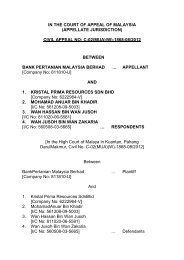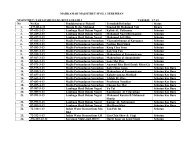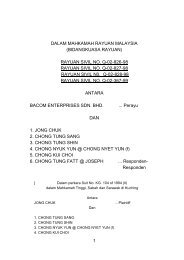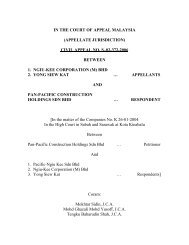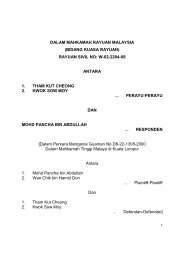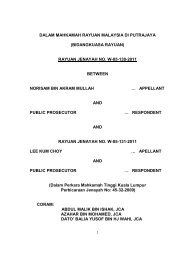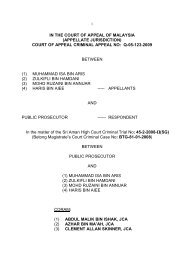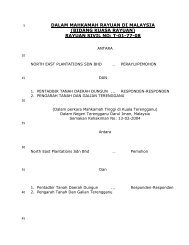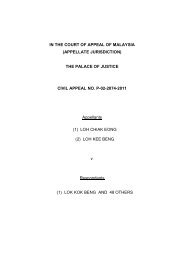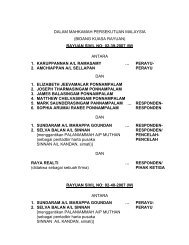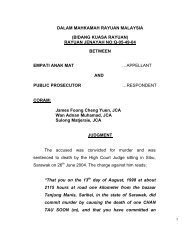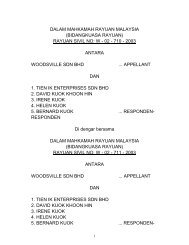mahkamah rayuan rayuan jenayah no: n-05-30-2003 antara am
mahkamah rayuan rayuan jenayah no: n-05-30-2003 antara am
mahkamah rayuan rayuan jenayah no: n-05-30-2003 antara am
You also want an ePaper? Increase the reach of your titles
YUMPU automatically turns print PDFs into web optimized ePapers that Google loves.
DALAM MAHKAMAH PERSEKUTUAN MALAYSIA<br />
RAYUAN JENAYAH NO : <strong>05</strong>-60-2008(N)<br />
(MAHKAMAH RAYUAN RAYUAN JENAYAH NO: N-<strong>05</strong>-<strong>30</strong>-<strong>2003</strong><br />
ANTARA<br />
AMATHEVELLI A/P P. RAMASAMY … PERAYU<br />
DAN<br />
PENDAKWA RAYA … RESPONDEN<br />
KORAM: ARIFIN BIN ZAKARIA, CJM<br />
AUGUSTINE PAUL, FCJ<br />
ZULKEFLI BIN AHMAD MAKINUDIN, FCJ<br />
Background<br />
JUDGMENT OF THE COURT<br />
The appellant was charged In the High Court at Seremban for the<br />
offence of murder under section <strong>30</strong>2 of the Panel Code. The charge<br />
reads as follows:<br />
1
“Bahawa k<strong>am</strong>u pada 17.5.1998, di <strong>antara</strong> j<strong>am</strong> 6.50 pagi<br />
hingga j<strong>am</strong> 10.00 pagi, dikedai runcit No. 156, Lorong 4,<br />
K<strong>am</strong>pong Gatco, Air Hit<strong>am</strong>, di dal<strong>am</strong> Daerah Jempol, di<br />
dal<strong>am</strong> Negeri, Negeri Sembilan telah melakukan<br />
pembunuhan dengan menyebabkan kematian<br />
SOOSAIMMAH A/P AROKIASAMY, K/P: 660<strong>30</strong>1-<strong>05</strong>-<br />
5456 dan dengan itu melakukan satu kesalahan yang<br />
boleh dihukum di bawah Seksyen <strong>30</strong>2 Kanun<br />
Keseksaan.”<br />
On 8.11.2001 she was found guilty of the offence as charged and<br />
was convicted and sentenced to death. Her appeal to the Court of<br />
Appeal was dismissed on 16.2.2008 and she <strong>no</strong>w appeals to this<br />
Court.<br />
Brief Facts<br />
On the fateful day Gabrial a/l S. Raju (SP7), the husband of the<br />
deceased, had left his house for the market at around 7.00 <strong>am</strong>. He<br />
returned home at about 10.00 <strong>am</strong> and found his child crying. He was<br />
told that the deceased had left the house since morning and had <strong>no</strong>t<br />
returned. He then brought the child to their sundry shop located<br />
about 50 meters from his house. He found that the shop was<br />
unlocked. Upon entering the shop he found the deceased sprawled<br />
on the floor covered in blood. He then called the police. In the mean<br />
time he conducted a check in the shop and found that a sum of<br />
2
RM500 – RM600 he had kept in the drawer of the cashier’s counter<br />
missing. He also found the deceased’s chain missing which he had<br />
seen her wearing before he left for the market that very morning.<br />
The Investigating Officer of the case, Chief Inspector Yong Soun Lian<br />
(SP13), arrived at the scene at about 11.20 <strong>am</strong>. He said that he<br />
found the deceased’s body lying on the floor near the cashier’s<br />
counter. It was covered with blood and smelt of formic acid. He<br />
recovered an empty formic acid bottle from the vegetable rack and a<br />
blood stained knife. He also recovered a broken stool. SP13 also<br />
found an identity card belonging to one Sh<strong>am</strong>suri bin Hashim (SP6)<br />
on the cashier’s counter. PW6 was subsequently arrested and later<br />
released as the investigation revealed that he was <strong>no</strong>t involved in the<br />
commission of the crime. Upon ex<strong>am</strong>ination of the body of the<br />
deceased, SP13 found a slash wound on her neck.<br />
The post-mortem conducted by Dr. Zahari b. Noor (SP9), a forensic<br />
pathologist, on the deceased disclosed that she had numerous<br />
injuries including scalding on the head, face, chest and hands. The<br />
cause of death according to SP9 was a slash wound at the right side<br />
of the neck which severed off the sterna mastoid muscle and carotid<br />
artery vein, causing massive bleeding. SP9 also testified that the<br />
knife (P19B) recovered from the scene could have caused the injury.<br />
He also stated that the deceased had some defensive wounds. The<br />
scalding, according to SP9, was due to the deceased coming into<br />
contact with acid.<br />
3
The appellant was arrested on 18 May 1998. Scalding marks were<br />
detected on the appellant and she was later ex<strong>am</strong>ined by Dr. Sandra<br />
Krishnan (SP14) on the s<strong>am</strong>e day and SP14 was of the opinion that<br />
the scalding marks found on the appellant were caused by the<br />
appellant coming into contact with acid and the injuries were one or<br />
two days old.<br />
The appellant’s husband Durairaj a/l Kolandaveloo (SP10) gave<br />
evidence for the prosecution. He stated that at the material time he<br />
was living with the appellant and their children at house No. 1<strong>30</strong>,<br />
Jalan 5, Kg. Gatco. They both worked as rubber tappers. On the day<br />
in question he said he left the house to tap rubber at about 5.<strong>30</strong> <strong>am</strong>.<br />
The appellant did <strong>no</strong>t go with him. She c<strong>am</strong>e later at between 6.<strong>30</strong><br />
<strong>am</strong> and 7.<strong>30</strong> <strong>am</strong> on a Y<strong>am</strong>aha motor cycle bearing registration No.<br />
ND 2480. She left the rubber plantation at about 9.<strong>30</strong> <strong>am</strong> saying that<br />
she was <strong>no</strong>t well.<br />
While she was in police custody she gave information to the police<br />
which led to the recovery of the gold chain (P40) and lockets (P44A-<br />
F) in a cupboard of her house. The cupboard was locked and was<br />
opened by the appellant using a key found on a chain worn by her<br />
around her neck. P40 was identified by SP7 to be the gold chain<br />
belonging to the deceased. Learned counsel for the appellant took<br />
issue on the admissibility of the information which led to the recovery<br />
of P40. I shall deal with this issue in a later part of the judgment.<br />
4
At the close of the prosecution’s case the learned trial Judge found<br />
that the prosecution had made out a prima facie case and called<br />
upon the appellant to enter her defence.<br />
She elected to give evidence on oath. She said that she had <strong>no</strong><br />
quarrel with the deceased. On the morning in question she went to<br />
the deceased’s shop at about 9.00 <strong>am</strong>. She entered the shop and as<br />
she approached the cashier’s counter, she saw a male Malay<br />
strangling the deceased using a rope. She immediately ran out of the<br />
shop but was stopped at the entrance by a<strong>no</strong>ther Malay male by<br />
holding both her shoulders and punching her on her lips. The man<br />
also splashed acid on the left side of her face and arm. That explains<br />
the injury on her lips and arm.<br />
She managed to free herself from the man and after that she went<br />
straight to work. She went home with her husband at about 8.<strong>30</strong> –<br />
9.00 <strong>am</strong>. She claimed that she had told her husband about the<br />
incident at the shop.<br />
She denied killing the deceased. She also claimed that she never<br />
told the police that the gold chain and lockets (P40 and P44A-F) were<br />
in her possession.<br />
The Issues<br />
Before us learned counsel for the appellant raised two main grounds<br />
in support of the appeal. The first relates to the delay of the learned<br />
5
trial Judge in supplying the written grounds of judgment and the<br />
second relates to the admissibility of P51; the statement leading to<br />
the recovery of P40 and P44A-F.<br />
Delay in supplying the grounds of judgment by the trial Judge<br />
This ground of appeal is contained in grounds 1, 2 and 3 of the<br />
petition of appeal which read:<br />
“1. The learned Judges of the Court of Appeal misdirected<br />
themselves in <strong>no</strong>t concluding that the i<strong>no</strong>rdinate and<br />
unexplained delay of 5 years in supplying the grounds of<br />
judgment after <strong>no</strong>tice of appeal had been filed had<br />
occasioned a manifest miscarriage of justice in that there<br />
would have been prejudice caused to the accused on the<br />
basis that there was every likelihood <strong>no</strong>t only that the trial<br />
Judge’s impression of demea<strong>no</strong>ur of witnesses would be<br />
blurred but also the delay would have increased the<br />
chances of omission on the part of the learned trial Judge<br />
to deal with material facts and issues in the grounds of<br />
judgment which would have been favourable to the<br />
appellant.<br />
2. In ruling that the delay referred to in ground I herein had<br />
<strong>no</strong>t caused prejudice to the appellant, the learned Judges<br />
of the Court of Appeal were, with respect, only<br />
encouraging delay in delivery of judgment by trial judges<br />
6
which was, in effect, a disservice to the administration of<br />
justice in the country, particularly so, when there was<br />
obvious defiance by the learned trial Judges of the<br />
circular of the Chief Justice requiring judges to supply<br />
their grounds of judgment within 8 weeks from the date on<br />
which <strong>no</strong>tice of appeal was filed, contravention of which<br />
could expose a judge to face a tribunal for misconduct.<br />
3. The learned Judges of the Court of Appeal should have<br />
been proactive in holding that the i<strong>no</strong>rdinate and<br />
unexplained delay had, under the circumstances<br />
obtaining in the appellant’s case, caused her serious<br />
prejudice.”<br />
On this issue we agree with learned counsel for the appellant that<br />
there was indeed an i<strong>no</strong>rdinate delay on the part of the learned trial<br />
Judge in furnishing his grounds of judgment as it took him five years<br />
to do so. Learned counsel submitted before us that in this case the<br />
learned Judge was in fact pressured into writing his judgment as the<br />
matter was raised in the press. Therefore on these grounds, as<br />
raised in the petition, he submitted, this is a fit and proper case for<br />
this Court to order a retrial.<br />
The Court of Appeal in the judgment written by Raus Sharif, JCA took<br />
the view that delay per se in supplying the written judgment by the<br />
trial judge does <strong>no</strong>t automatically render the decision of the trial judge<br />
to be vitiated or liable to be set aside. The Court relied on the view<br />
7
expressed by the then Supreme Court in Tan Hun Wah v. Public<br />
Prosecutor and a<strong>no</strong>ther appeal (1994) 1 MLJ 382 and said:<br />
“In the present case, it took the learned trial judge about five<br />
years to supply the grounds of judgment to the accused. It is<br />
regrettable, but we are of the s<strong>am</strong>e view with the Supreme<br />
Court that it should <strong>no</strong>t necessarily result in vitiating the whole<br />
proceedings. This is more so when it is <strong>no</strong>t shown to us<br />
through the <strong>no</strong>tes of evidence that the appellant has suffered<br />
prejudice as the result of the delay in supplying the grounds of<br />
judgment to the accused. Further, we hold the view that in the<br />
administration of justice, the courts must be fair <strong>no</strong>t only to the<br />
accused person, but must also be fair to the State and society.<br />
It would <strong>no</strong>t be fair to the State and society whose penal law<br />
are made and administered, if the accused is given an outright<br />
acquittal just because of the delay in supplying the grounds of<br />
judgment. This is especially so when the accused has been<br />
found guilty of a serious crime of murder. We, therefore hold<br />
that this appeal must be heard on its merits.”<br />
A pertinent observation made by Moh<strong>am</strong>ad Azmi SCJ in Tan Hun<br />
Wah (supra) is this:<br />
“The principle that ‘Justice delayed is justice denied’ is of<br />
general application, and it does <strong>no</strong>t follow that every form<br />
of delay, though frowned upon by the courts, should result<br />
in vitiating the whole proceedings.”<br />
8
Delay could occur in two ways; delay in making decisions and delay<br />
in delivery of written grounds of judgment. These are two separate<br />
things. In some cases the decisions are made earlier and the written<br />
grounds are supplied at a later date, while in others both are<br />
delivered at one and the s<strong>am</strong>e time, especially where judgment is<br />
reserved. Ideally when a decision is reserved the court should deliver<br />
its decision coupled with a written grounds of judgment. This would<br />
expedite the disposal of any appeal that may follow. In the present<br />
case the trial commenced on 25.1.2000 and was concluded on<br />
25.11.2000 after several adjournments: at the end of which the trial<br />
judge adjourned it for parties to file written submissions. It was <strong>no</strong>t<br />
until 8.11.2002 that the trial Judge delivered his decision.<br />
Having adjourned the matter for close to two years <strong>no</strong> written grounds<br />
of decision was made available. The trial Judge merely delivered an<br />
oral decision. The written grounds of decision or judgment was <strong>no</strong>t<br />
forthcoming until 5.12.2007; a period of five years. This is clearly a<br />
case of serious dereliction of duty on the part of the trial Judge which<br />
can<strong>no</strong>t be condoned. In Public Prosecutor v. R<strong>am</strong>anathan a/l<br />
Chelliah, Rayuan Jenayah No. W-09-4-20<strong>05</strong>, Zainun binti Ali, JCA<br />
aptly remarked:<br />
“Make <strong>no</strong> mistake that we are unanimous is our view that<br />
delay in preparing and supplying grounds of judgment in<br />
itself is a malaise that must be resisted as far as possible.<br />
It is an aberration much to be abhorred.”<br />
9
We would <strong>no</strong>t say more on this, save that actions have been taken by<br />
the current Chief Justice to address this issue of delay in delivering<br />
written judgments, as had happened in this case.<br />
In this case we have ex<strong>am</strong>ined the authorities cited to us by the<br />
learned counsel for the appellant but we find <strong>no</strong>ne that goes to<br />
support the proposition that delay per se in supplying the written<br />
grounds of judgment is sufficient to render the decision of the trial<br />
Judge to be vitiated or liable to be set aside. The learned Judge may<br />
in appropriate cases be castigated but that is <strong>no</strong>t a sufficient reason<br />
to quash the conviction. Take the case of Voon Chin Fatt v. Public<br />
Prosecutor (1948-49) MLJ Supp. 131, where there was a delay of two<br />
years in delivering the grounds of judgment. Spenser Wilkinson J.<br />
allowed the appeal by the accused/appellant for two reasons, n<strong>am</strong>ely,<br />
the delay in delivering the grounds of judgment which he said could<br />
have prejudiced the appellant’s case and, secondly, because of the<br />
confusion between admissible and inadmissible evidence and of the<br />
fact that the admissible evidence was <strong>no</strong>t as unassailable as the trial<br />
Judge appeared to have thought. So on these two grounds the<br />
learned Judge found that the conviction could <strong>no</strong>t stand. Hence<br />
delay in supplying grounds of judgment was <strong>no</strong>t the single reason<br />
that prompted the learned Judge to come to the decision that he did.<br />
Similarly in Tan Hun Wah v. Public Prosecutor and a<strong>no</strong>ther appeal<br />
(supra), it was held that delay alone is <strong>no</strong>t a sufficient ground to<br />
cause the proceedings to be vitiated, there must be more to it. In that<br />
case the failure of the prosecution to call one Alenalli Singh or offer<br />
10
him as a witness was held to be a fatal omission which together with<br />
the long delay in the court proceedings was sufficient to have<br />
prejudiced the appellant.<br />
Therefore, it is necessary for the appellant in the present case to go<br />
one step further and demonstrate to us through the <strong>no</strong>tes of evidence<br />
the manner in which the appellant had been prejudiced by the delay<br />
to warrant a vitiation of the whole proceedings. This, learned counsel<br />
for the appellant failed to do. On that premise we are of the view that<br />
the Court of Appeal had correctly dismissed this ground in the appeal<br />
by the appellant.<br />
Section 27 of the Evidence Act 1950<br />
The second ground of appeal relates to the recovery of P40, the<br />
deceased’s gold chain from the appellant’s house pursuant to the<br />
information given by the appellant to SP12 which was recorded by<br />
him in P51. The information, after expunging the offending words,<br />
reads as follows:<br />
“Encik, rantai leher emas yang saya <strong>am</strong>bil daripada<br />
perempuan ….. itu ada saya simpan di rumah saya di No.<br />
1<strong>30</strong>, Jalan 5, NUPW Gatco, Air Hit<strong>am</strong>. Saya boleh bawa<br />
encik dan tunjukkan di mana saya simpan rantai leher<br />
emas tersebut.”<br />
11
Mr Karpal Singh, learned counsel for the appellant, contended that it<br />
is <strong>no</strong>t disputed that in P51, SP12 did <strong>no</strong>t record the questions which<br />
led to the information being given by the appellant and that even in<br />
his oral testimony SP12 did <strong>no</strong>t advert to any questions which were<br />
asked by him which led to the information being given which was as<br />
recorded in P51. Relying on Public Prosecutor v. Khoo Boo Hock &<br />
A<strong>no</strong>r (1990) 1 CLJ 971 and Public Prosecutor v. Hashim Bin Hanafi<br />
(2002) 4 MLJ 176, it was submitted that the information given by the<br />
appellant should have been ruled inadmissible, with the result that the<br />
recovery of P40 and P44 A - F could <strong>no</strong>t be linked to the appellant.<br />
Without the evidence of P51 the other circumstantial evidence are, in<br />
his submission, insufficient to constitute proof of the case against the<br />
appellant beyond a reasonable doubt.<br />
However, as submitted by the learned DPP, looking at P51 one will<br />
find the question put to the appellant by SP12. The question reads:<br />
“Apakah yang k<strong>am</strong>u ingin memberi pengakuan kepada<br />
saya?”<br />
Further we agree with the learned DPP that section 27 does <strong>no</strong>t<br />
require the question to be recorded before the information may be<br />
admitted under the said section. It is true that in PP v. Hashim bin<br />
Hanafi (supra) Augustine Paul J (as he then was) did make the<br />
observation that evidence of the question asked is imperative on the<br />
facts of a particular case in order to have a proper appreciation of the<br />
answer. He said that in certain circumstances the question asked<br />
12
has to be read with the answer given by the accused as otherwise the<br />
answer would <strong>no</strong>t make any sense. However, the learned Judge<br />
made it clear that it is <strong>no</strong>t in every case that the question needed to<br />
be adduced in evidence, it all depends on the facts of each case. In<br />
that case the accused was charged with trafficking in 13,767.51<br />
gr<strong>am</strong>s of cannabis. The question asked was whether he had any<br />
incriminating articles in his custody and control. The response by the<br />
accused was his act of pointing out exhibit P17 to SP4. The learned<br />
Judge held that the question appeared to give evidentiary value and<br />
weight to the answer given. Without the question he held that the<br />
evidence of the act of pointing out the drugs by the accused is of little<br />
value; at the highest it shows that the accused merely had k<strong>no</strong>wledge<br />
of the dangerous drugs but such k<strong>no</strong>wledge in law could <strong>no</strong>t<br />
constitute possession.<br />
In P.P. v. Khoo Boo Hock & A<strong>no</strong>r (supra) Edgar Joseph Jr. J (as he<br />
then was) held that in the circumstances of the case the prosecution<br />
must prove beyond reasonable the actual questions put to the<br />
accused in order to find out precisely what information was intended<br />
to be conveyed by the accused which led to the discovery of the<br />
drugs.<br />
In the present case the question put to the appellant is contained in<br />
P51. What may be considered as objectionable is the words ‘….<br />
memberi pengakuan kepada saya?’ appearing in the question which<br />
may literally be translated to mean ‘…… confess to me’. The answer<br />
given by the appellant read together with the question can be<br />
13
construed as an admission by the appellant to the offence for which<br />
she was being charged. On that premise the question ought <strong>no</strong>t in<br />
the circumstances to have been admitted as evidence as its<br />
prejudicial effect far outweigh its evidential value. Be that as it may, I<br />
agree with the prosecution that the information in itself is a complete<br />
statement without having to resort to the question. The objection<br />
raised by the learned counsel can<strong>no</strong>t therefore be sustained.<br />
However, that is <strong>no</strong>t the end of the matter in so far as the admissibility<br />
of the information supplied by the appellant is concerned. The only<br />
evidence adduced by the Prosecution of the information is the record<br />
of it as contained in P51. SP12 did <strong>no</strong>t give any oral evidence of it. In<br />
commenting on the manner of giving evidence of information received<br />
under section 27, Augustine Paul J (as he then was) said in Public<br />
Prosecutor v Hashim bin Hanafi (supra) at page 185 – 186:<br />
“Information given under s. 27 is <strong>no</strong>t a matter that is<br />
required by law to be in writing so as to be governed by<br />
ss. 91 and 92 of the Act. Therefore the information must<br />
be proved by oral evidence pursuant to s. 60(b) of the<br />
Act. Thus a written record of the information given by the<br />
accused will <strong>no</strong>t by itself be substantive evidence of its<br />
contents and it is what the witness deposes in court as<br />
having been said by the accused that will be evidence<br />
(see Bhagirath). Where the information is contained in a<br />
police diary it can only be used for the purpose of<br />
refreshing memory (see Public Prosecutor v Er Ah Kiat<br />
14
[1966] 1 MLJ 9). Where it is contained in any other<br />
document it can, at the highest, serve only as evidence of<br />
corroboration. It is on this basis that a report prepared by<br />
a chemist pertaining to his analysis of drugs can<strong>no</strong>t be<br />
tendered as substantive evidence of its contents but only<br />
as corroboration of his oral evidence in court under s. 157<br />
of the Act (see Saw Thean Teik v R [1953] MLJ 124;<br />
Muh<strong>am</strong>med bin Hassan v Public Prosecutor [1998] 2 MLJ<br />
273). The purpose of corroboration is <strong>no</strong>t to give validity<br />
or credence to evidence which is deficient or suspect or<br />
incredible but only to confirm and support that which as<br />
evidence is sufficient and satisfactory and credible (see<br />
DPP v Hester [1972] 3 All ER 1<strong>05</strong>6). Its role is to confirm<br />
other evidence in the sense that it renders that other<br />
evidence more probable (see Doney v R (1990) 171 CLR<br />
207; DPP v Kilbourne [1973] AC 729). It can<strong>no</strong>t therefore<br />
<strong>am</strong>ount to that other evidence itself. Thus the record of an<br />
information will only enhance the credibility of the witness<br />
and the absence of it can<strong>no</strong>t render the oral evidence of it<br />
inadmissible; <strong>no</strong>r can it be a substitute for the evidence<br />
that it is meant to corroborate.”<br />
It is therefore clear that there must be oral evidence of the information<br />
given. P51 can<strong>no</strong>t be a substitute for it. Accordingly, we hold that<br />
P51, the information supplied under section 27 by the appellant, is<br />
inadmissible.<br />
15
Evidence of Subsequent Conduct:<br />
The inadmissibility of the information supplied by the appellant does<br />
<strong>no</strong>t affect the admissibility of the evidence of her subsequent conduct<br />
under section 8 of the Evidence Act irrespective of section 27. As<br />
Chinnappa Reddy J said in Prakash Chand v State AIR SC 400 at<br />
page 404:<br />
“The evidence of the circumstances, simpliciter, that an<br />
accused person led a police officer and pointed out the<br />
place where stolen articles or weapon which might have<br />
been used in the commission of the offence were found<br />
hidden, would be admissible as conduct, under section 8<br />
of the Evidence Act, irrespective of whether any<br />
statement by the accused contemporaneously will or<br />
antecedent to such conduct falls within the purview of<br />
section 27 of the Evidence Act (vide Himachal Pradesh<br />
Administration v Om Prakash AIR 1972 SC 975).”<br />
The evidence of conduct of the appellant in this case are as follows:<br />
(a) Bringing the police te<strong>am</strong> to her house;<br />
(b) Using the key attached to the chain that she was wearing to<br />
open the cupboard;<br />
(c) Taking out a folded green blouse from the cupboard; and<br />
(d) Taking out from the blouse a folded handkerchief containing<br />
P40 and P44A – F which belonged to the deceased.<br />
16
SP10 said in his evidence that he had never seen the gold chain<br />
before. SP7 said that the gold chain that the deceased was wearing<br />
on the fateful morning was missing. He identified P40 and P44A - F<br />
as that of the deceased. Thus the appellant was clearly in possession<br />
of recently stolen goods. Under section 114(a) of the Evidence Act it<br />
may be presumed that a man who is in possession of stolen goods<br />
soon after the theft is either the thief or has received the goods<br />
k<strong>no</strong>wing them to be stolen, unless he can account for his possession.<br />
This presumption can also be indicative of any other more<br />
aggravated crime which has been connected with the theft. As<br />
Matthew CJ said in Abdullah bin Saad v Public Prosecutor (1956)<br />
MLJ 92 at page 92 – 93:<br />
“Presumably, the statutory presumption was illustration<br />
(a) of section 114 of the Evidence Ordinance, which<br />
reads:--<br />
“The Court may presume –<br />
(a) that a man who is in possession of stolen goods<br />
soon after the theft is either the thief or has<br />
received the goods k<strong>no</strong>wing them to be stolen,<br />
unless he can account for his possession;”<br />
Wills on Circumstantial Evidence, 7 th Edition, p. 104 has<br />
the following passage: --<br />
The possession of stolen goods recently after the loss of<br />
them, may be indicative <strong>no</strong>t merely of the offence of<br />
17
larceny, or of receiving with guilty k<strong>no</strong>wledge, but of any<br />
other more aggravated crime which has been connected<br />
with theft. Upon an indictment for arson, proof that<br />
property which was in the house at the time it was burnt,<br />
was soon afterwards found in the possession of the<br />
prisoner, was held to raise a presumption that he was<br />
present at, and concerned in, the offence; R v Rockman<br />
(1789) 2 East PC p1035, and see R v Fuller (1816) R & R<br />
<strong>30</strong>8. This particular fact of presumption commonly forms<br />
also a material element of evidence in cases of murder;<br />
which special application of it has often been emphatically<br />
recognised. It is upon the s<strong>am</strong>e principle that a sudden<br />
and otherwise inexplicable transition from a state of<br />
indigence and a consequent change of habits or a<br />
profuse or unwanted expenditure inconsistent with the<br />
position in life of the party, is sometimes a circumstance<br />
extremely unfavourable to the supposition of in<strong>no</strong>cence<br />
(R. v Burdock) (murder by poison) Bristol Assn. Ap.1835,<br />
Cor: Sir Charles Wetherell, Recorder.<br />
But the rule must be applied with discrimination, for the<br />
bare possession of stolen property, though recent,<br />
uncorroborated by other evidence, is sometimes<br />
fallacious and dangerous as a criterion of guilt.<br />
In the present case, the only evidence to connect the<br />
appellant with the killing is the possession of two pieces<br />
18
of jewellery, the property of the deceased, and it is <strong>no</strong>t<br />
certain that they were on the deceased's person on the<br />
day of his death. In our view, this did <strong>no</strong>t supply sufficient<br />
evidence on which to found a conviction for murder, and<br />
we accordingly allowed the appeal and directed that the<br />
appellant should be discharged.”<br />
In this case the deceased was wearing the gold chain at the time of<br />
her death. This is a material element to connect the appellant to the<br />
murder of the deceased. This is further supported by other evidence<br />
such as, the acid injury on the appellant’s lips and arm when the<br />
deceased also had acid injuries and the presence of the Y<strong>am</strong>aha<br />
motorcycle at the deceased’s shop at about 7.<strong>05</strong> <strong>am</strong> on the material<br />
date. Thus, the evidence is sufficient to convict the appellant for the<br />
murder of the deceased. The inferences drawn from the evidence of<br />
conduct of the appellant will remain as she has <strong>no</strong>t explained them<br />
pursuant to section 9 of the Evidence Act. As Augustine Paul FCJ<br />
said in the judgment of this Court in Parlan bin Dadeh v Public<br />
Prosecutor (2008) 6 MLJ 19 at page 44:<br />
“If the explanation is accepted by the Court then the<br />
inference arising from the conduct is rebutted. If it is <strong>no</strong>t<br />
accepted or if the accused does <strong>no</strong>t explain his conduct<br />
the inference remains unrebutted.”<br />
19
Similarly the presumption arising from section 114(a) of the Evidence<br />
Act also remains as the possession of the gold chain by the appellant<br />
has <strong>no</strong>t been explained by her as required.<br />
Defence<br />
Further we have considered the defence put up by the appellant. We<br />
agree with the observation of the Court of Appeal that the defence put<br />
up by the appellant when tested against the totality of the evidence<br />
adduced is difficult to be believed. More importantly it failed to raise<br />
any reasonable doubt in the prosecution’s case. The appellant in her<br />
evidence did <strong>no</strong>t offer any explanation whatsoever as to how she<br />
c<strong>am</strong>e to be in possession of the deceased’s jewellery. It is our<br />
finding, therefore, that both the trial Court and the Court of Appeal<br />
had rightly concluded that the circumstantial evidence before the<br />
court irresistibly points to the guilt of the appellant.<br />
Conclusion<br />
For the above reasons we find that the appeal herein is devoid of any<br />
merit and must be dismissed. The conviction and sentence imposed<br />
by the High Court is hereby affirmed.<br />
20
Dated: 19 January 2009<br />
( DATO’ ARIFIN BIN ZAKARIA )<br />
Chief Judge of Malaya<br />
Date of Hearing : 10.9.2008<br />
Date of Decision : 19.1.2009<br />
Counsel for Appellant : Karpal Singh & R<strong>am</strong>karpal Singh<br />
Solicitors for Appellant : Messrs Karpal Singh & Company<br />
No. 67, Jalan Pudu L<strong>am</strong>a<br />
50200 Kuala Lumpur<br />
Counsel for Respondent : Mangaiarkarasi a/p Krishnan<br />
TPP, Jab. Pegu<strong>am</strong> Negara &<br />
Nurulhuda Nur’aini bt. Mohd. Noor<br />
Solicitors for Respondent : Bahagian Pendakwaan<br />
Jabatan Pegu<strong>am</strong> Negara<br />
Malaysia<br />
21



